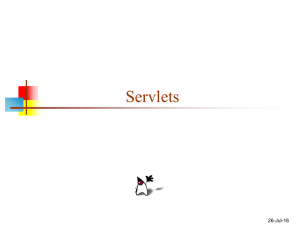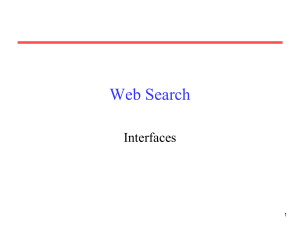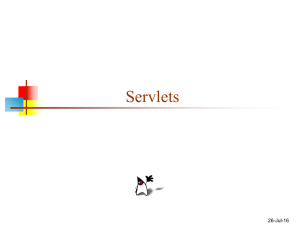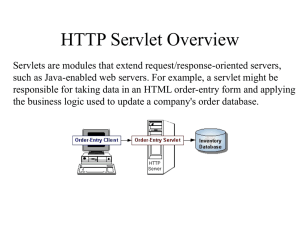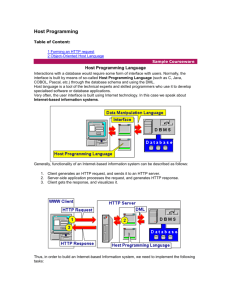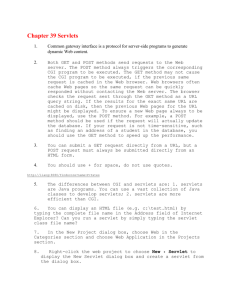Servlets
advertisement
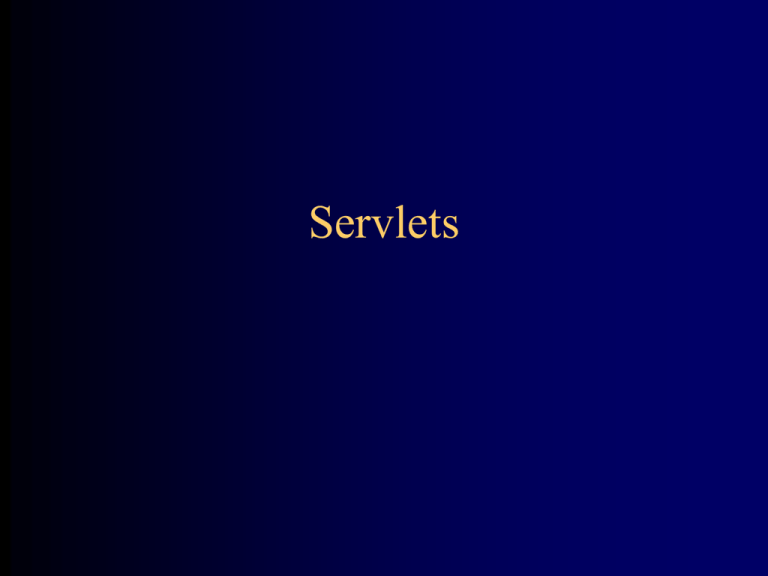
Servlets
Servers
• A server is a computer that responds to requests from a
client
– Typical requests: provide a web page, upload or download a file,
send email
• A server is also the software that responds to these
requests; a client could be the browser or other software
making these requests
• Typically, your little computer is the client, and someone
else’s big computer is the server
– However, any computer can be a server
– It is not unusual to have server software and client software
running on the same computer
Apache
• Apache is a very popular server
– 63% of the web sites on the Internet use Apache
• Apache is:
–
–
–
–
–
–
–
Full-featured and extensible
Efficient
Robust
Secure (at least, more secure than other servers)
Up to date with current standards
Open source
Free
• Why use anything else?
Ports
• A port is a connection between a server and a client
– Ports are identified by positive integers
– A port is a software notion, not a hardware notion, so there may be
very many of them
• A service is associated with a specific port
– Typical port numbers:
•
•
•
•
•
•
•
•
21—FTP, File Transfer Protocol
22—SSH, Secure Shell
25—SMTP, Simple Mail Transfer Protocol
53—DNS, Domain Name Service
80—HTTP, Hypertext Transfer Protocol
8080—HTTP (used for testing HTTP)
7648, 7649—CU-SeeMe
27960—Quake III
These are the ports
of most interest to us
Ports II
• My UPenn Web page is:
http://www.cis.upenn.edu/~matuszek
• But it is also:
http://www.cis.upenn.edu:80/~matuszek
• The http: at the beginning signifies a particular protocol
(communication language), the Hypertext Transfer Protocol
• The :80 specifies a port
• By default, the Web server listens to port 80
– The Web server could listen to any port it chose
– This could lead to problems if the port was in use by some other server
– For testing servlets, we typically have the server listen to port 8080
• In the second URL above, I explicitly sent my request to port 80
– If I had sent it to some other port, say, 99, my request would either go
unheard, or would (probably) not be understood
CGI Scripts
• CGI stands for “Common Gateway Interface”
Client sends a request to server
Server starts a CGI script
Script computes a result for server
and quits
Server returns response to client
Another client sends a request
Server starts the CGI script again
Etc.
client
server
client
script
Servlets
• A servlet is like an applet, but on the server side
Client sends a request to server
Server starts a servlet
Servlet computes a result for
server and does not quit
Server returns response to client
Another client sends a request
Server calls the servlet again
Etc.
client
server
client
servlet
Servlets vs. CGI scripts
• Advantages:
– Running a servlet doesn’t require creating a separate
process each time
– A servlet stays in memory, so it doesn’t have to be
reloaded each time
– There is only one instance handling multiple requests,
not a separate instance for every request
– Untrusted servlets can be run in a “sandbox”
• Disadvantage:
– Less choice of languages (CGI scripts can be in any
language)
Tomcat
• Tomcat is the Servlet Engine than handles servlet requests
for Apache
– Tomcat is a “helper application” for Apache
– It’s best to think of Tomcat as a “servlet container”
• Apache can handle many types of web services
– Apache can be installed without Tomcat
– Tomcat can be installed without Apache
• It’s easier to install Tomcat standalone than as part of
Apache
– By itself, Tomcat can handle web pages, servlets, and JSP
• Apache and Tomcat are open source (and therefore free)
Servlets
• A servlet is any class that implements the
javax.servlet.Servlet interface
– In practice, most servlets extend the
javax.servlet.http.HttpServlet class
– Some servlets extend javax.servlet.GenericServlet
instead
• Servlets, like applets, usually lack a main method,
but must implement or override certain other
methods
Important servlet methods, I
• When a servlet is first started up, its init(ServletConfig
config) method is called
– init should perform any necessary initializations
– init is called only once, and does not need to be thread-safe
• Every servlet request results in a call to
service(ServletRequest req, ServletResponse res)
– service calls another method depending on the type of service
requested
– Usually you would override the called methods of interest, not
service itself
– service handles multiple simultaneous requests, so it and the
methods it calls must be thread safe
• When the servlet is shut down, destroy() is called
– destroy is called only once, but must be thread safe (because other
threads may still be running)
HTTP requests
• When a request is submitted from a Web page, it is almost
always a GET or a POST request
• The HTTP <form> tag has an attribute action, whose
value can be "get" or "post"
• The "get" action results in the form information being put
after a ? in the URL
– Example:
http://www.google.com/search?hl=en&ie=UTF-8&oe=UTF8&q=servlets
– The & separates the various parameters
– Only a limited amount of information can be sent this way
• "put" can send large amounts of information
Important servlet methods, II
• The service method dispatches the following kinds of
requests: DELETE, GET, HEAD, OPTIONS, POST, PUT, and
TRACE
– A GET request is dispatched to the doGet(HttpServletRequest
request, HttpServletResponse response) method
– A POST request is dispatched to the doPost(HttpServletRequest
request, HttpServletResponse response) method
– These are the two methods you will usually override
– doGet and doPost typically do the same thing, so usually you do
the real work in one, and have the other just call it
– public void doGet(HttpServletRequest request,
HttpServletResponse response) {
doPost(request, response);
}
A “Hello World” servlet
(from the Tomcat installation documentation)
public class HelloServlet extends HttpServlet {
public void doGet(HttpServletRequest request,
HttpServletResponse response)
throws ServletException, IOException {
response.setContentType("text/html");
PrintWriter out = response.getWriter();
String docType =
"<!DOCTYPE HTML PUBLIC \"-//W3C//DTD HTML 4.0 " +
"Transitional//EN\">\n";
out.println(docType +
"<HTML>\n" +
"<HEAD><TITLE>Hello</TITLE></HEAD>\n" +
"<BODY BGCOLOR=\"#FDF5E6\">\n" +
"<H1>Hello World</H1>\n" +
"</BODY></HTML>");
}
Don’t worry, we’ll take this a little at a time!
}
The superclass
• public class HelloServlet extends HttpServlet {
• Every class must extend GenericServlet or a
subclass of GenericServlet
– GenericServlet is “protocol independent,” so you could
write a servlet to process any protocol
– In practice, you almost always want to respond to an
HTTP request, so you extend HttpServlet
• A subclass of HttpServlet must override at least
one method, usually one doGet, doPost, doPut,
doDelete, init and destroy, or getServletInfo
The doGet method
•
•
•
•
•
•
•
public void doGet(HttpServletRequest request,
HttpServletResponse response)
throws ServletException, IOException {
This method services a GET request
The method uses request to get the information that was
sent to it
The method does not return a value; instead, it uses
response to get an I/O stream, and outputs its response
Since the method does I/O, it can throw an IOException
Any other type of exception should be encapsulated as a
ServletException
The doPost method works exactly the same way
Parameters to doGet
• Input is from the HttpServletRequest parameter
– Our first example doesn’t get any input, so we’ll
discuss this a bit later
• Output is via the HttpServletResponse object,
which we have named response
– I/O in Java is very flexible but also quite complex, so
this object acts as an “assistant”
Using the HttpServletResponse
• The second parameter to doGet (or doPost) is
HttpServletResponse response
• Everything sent via the Web has a “MIME type”
• The first thing we must do with response is set the MIME
type of our reply:
response.setContentType("text/html");
– This tells the client to interpret the page as HTML
• Because we will be outputting character data, we need a
PrintWriter, handily provided for us by the getWriter
method of response:
PrintWriter out = response.getWriter();
• Now we’re ready to create the actual page to be returned
Using the PrintWriter
• From here on, it’s just a matter of using our PrintWriter,
named out, to produce the Web page
• First we create a header string:
String docType =
"<!DOCTYPE HTML PUBLIC \"-//W3C//DTD HTML 4.0 " +
"Transitional//EN\">\n";
– This line is technically required by the HTML spec
– Browsers mostly don’t care, but HTML validators do care
• Then use the println method of out one or more times
out.println(docType +
"<HTML>\n" +
"<HEAD> ... </BODY></HTML>");
• And we’re done!
Input to a servlet
• A GET request supplies parameters in the form
URL ? name=value & name=value & name=value
– (Illegal spaces added to make it more legible)
– Spaces in the parameter values are encoded by + signs
– Special characters are encoded in hex; for example, an
ampersand is represented by %26
• Parameter names can occur more than once, with
different values
• A POST request supplies parameters in the same
syntax, only it is in the “body” section of the
request and is therefore harder for the user to see
Getting the parameters
• Input parameters are retrieved via messages to the
HttpServletRequest object request
– Most of the interesting methods are inherited from the
superinterface ServletRequest
• public Enumeration getParameterNames()
– Returns an Enumeration of the parameter names
– If no parameters, returns an empty Enumeration
• public String getParameter(String name)
– Returns the value of the parameter name as a String
– If the parameter doesn’t exist, returns null
– If name has multiple values, only the first is returned
• public String[] getParameterValues(name)
– Returns an array of values of the parameter name
– If the parameter doesn’t exist, returns null
Enumeration review
• An Enumeration is almost the same as Iterator
– It’s an older class, and the names are longer
• Example use:
– Enumeration e = myVector.elements();
while (e.hasMoreElements()) {
System.out.println(e.nextElement());
}
Example of input parameters
public void doGet(HttpServletRequest request,
HttpServletResponse response) {
... stuff omitted ...
out.println("<H1>Hello");
String names[] =
request.getParameterValues("name");
if (names != null)
for (int i = 0; i < names.length; i++)
out.println(" " + names[i]);
out.println("!");
}
Java review: Data from Strings
• All parameter values are retrieved as Strings
• Frequently these Strings represent numbers, and
you want the numeric value
– int n = new Integer(param).intValue();
– double d = new Double(param).doubleValue();
– byte b = new Byte(param).byteValue();
• Similarly for short, float, and long
• These can all throw a NumberFormatException, which is a
subclass of RuntimeException
– boolean p = new Boolean(param).booleanValue();
• But:
– char c = param.charAt(0);
What’s left?
• We’ve covered enough so far to write simple
servlets, but not enough to write useful servlets
– We still need to be able to:
•
•
•
•
•
•
Use configuration information
Authenticate users
Keep track of users during a session
Retain information across different sessions
Make sure our servlets are thread safe
Communicate between servlets
– But remember: The most difficult program in any
language is Hello World!
The End
